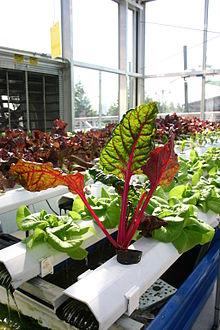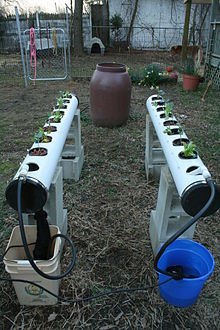Nutrient film technique
This ensures that the thick root mat which develops in the bottom of the channel receives adequate air exposure.
In earlier production systems, there was a conflict between the supply of these requirements, since excessive or deficient amounts of one results in an imbalance of one or both of the others.
On rapidly growing crops, tests have indicated that, while oxygen levels remain adequate, nitrogen may be depleted over the length of the gully.
In situations where this is not possible, the reductions in growth can be eliminated by placing another nutrient feed halfway along the gully and reducing flow rates to 1L/min through each outlet.
[3] Care needs to be taken to maintain hygienic conditions and to avoid heavy metal contamination of NFT systems by using mainly plastic or stainless steel pumps and components.
According to Cornell University’s Controlled Environment Agriculture group, a 5-to-6-ounce head of lettuce can be produced in 35 days (from seed to harvest) with proper inputs and conditions (Mattson).
Categorized as a fast-growing crop, approximately 60% of the total leaf area and 70% of the dry biomass are generated in the last 20 days of production.
Lettuce seedlings are placed in NFT channels 6 to 8 inches apart to provide enough room between crops for proper leaf development.
After harvest, all NFT channels should be properly sanitized and scrubbed to prevent the possibility of pathogen build up (Kaiser).
Dutch growers particularly rejected NFT because of the perceived high risk of disease spread by the recirculating solution.
Leafy crops like lettuce benefit from unlimited water supplies and are still widely grown using NFT, but now most commercial greenhouse crops of tomatoes, capsicums and cucumbers are grown hydroponically using some kind of inert media, with rockwool being the most important medium worldwide.

